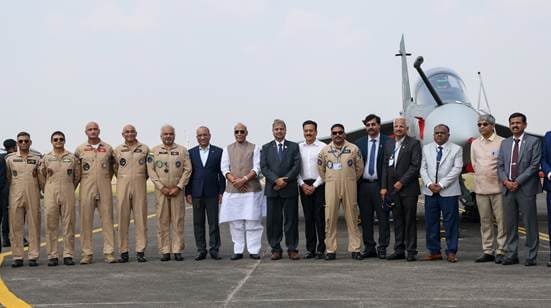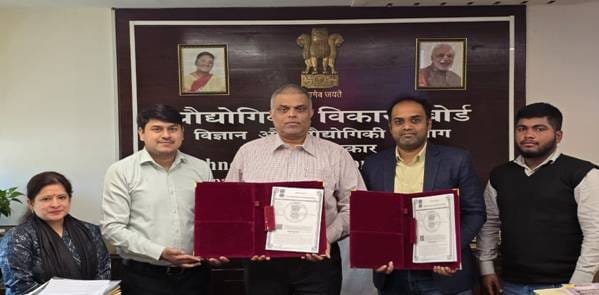India must always stay ahead of new race, says Minister
Defence Minister Rajnath Singh inaugurated the third Production Line of Light Combat Aircraft (LCA) Tejas Mk1A and the second Production Line of Hindustan Turbo Trainer-40 (HTT-40) at the Nashik facility of Hindustan Aeronautics Limited (HAL) on October 17, 2025.
He also flagged-off the first LCA Mk1A produced at the facility, saying it highlighted the transformation of the defence sector https://www.bseindia.com/.
The country, once imported 65-70% of critical military hardware, is now manufacturing 65% of the equipment on its own, said Rajnath Singh, underlining the Government’s resolve of increasing domestic manufacturing to 100% in the times to come https://www.nseindia.com/.
Listing out other feats achieved due to the Government’s consistent efforts, the Minister stated that annual defence production has surged to a record figure of over Rs.1.50 lakh crore in 2024-25 from Rs.46,429 crore in 2014-15.
Defence export touched an all-time high of Rs.25,000 crore in 2024-25 from less than Rs.1,000 crore a decade ago https://sbi.com.in/.
“We have now set a target of increasing defence manufacturing to Rs.3 lakh crore and exports to Rs.50,000 crore by 2029,” Rajnath Singh stressed.
On the constantly-evolving nature of modern-day warfare, he underscored the importance of staying ahead of the curve as Artificial Intelligence, cyber warfare, drone systems & next-generation aircraft are shaping the future, and wars are being fought across multiple frontiers.
“India must always stay ahead in this new race, and not lag behind,” he said, exhorting HAL to make its mark in the fields of next-generation aircraft, unmanned systems & civil aviation, and not limit itself to LCA Tejas or HTT-40.
Voicing the Government’s commitment towards inducting state-of-the-art, indigenous technologies, he appreciated the role of HAL in carrying forward the vision, terming the Defence Public Sector Undertaking as the backbone of India’s defence sector. He praised HAL for providing operational support to the recently-decommissioned MiG-21 https://usispf.org/.
The Minister lauded HAL Nashik for playing a pivotal role in taking India’s defence manufacturing capabilities to newer heights for over six decades – from manufacturing and overhauling fighter jets such as MiG-21 & MiG-27 to becoming the production house of Su-30, terming the campus as a glowing symbol of self-reliance.
Rajnath Singh pointed out that the ongoing construction of the LCA Tejas and HTT-40 aircraft is also the result of collaboration between various industry partners of the country. “This collaboration is proof that if the government, industries, and academia work together, no challenge is too big,” he said, acknowledging the trust placed by the Indian Air Force in aircraft such as Tejas and HTT-40.
On the joint Maintenance, Repair, and Overhaul facility for both civil and military aviation established in the Nashik division, he exuded confidence that the initiative will create new employment opportunities in Nashik and surrounding areas.
He also took note of the fact that the entire HAL complex is now paperless, digital, and completely sustainable. He called it a true symbol of New India’s technological leap http://gifas.asso.fr.
Speaking on the occasion, Secretary (Defence Production) Sanjeev Kumar described the inauguration of two production lines as a symbol of India’s growing technological confidence, industrial strength, and strategic foresight.
“The event marks a new chapter in HAL’s journey, one that enhances our nation’s production capacity and strengthens the foundation of a robust, self-sustaining aerospace ecosystem,” he said https://www.state.gov/.
The Secretary (DP) termed LCA Tejas Mk1 as not merely a fighter aircraft; but a statement of India’s design and manufacturing excellence – conceived, developed and produced indigenously through the collaboration of HAL, Aeronautical Development Agency, DRDO and the Indian Air Force.
He added that the HTT-40, fully designed and developed by HAL, stands as a shining example of the company’s ability to conceptualise, design and deliver critical defence platforms completely indigenously.
HAL CMD Dr DK Sunil termed the successful operationalisation of the LCA Mk1A and HTT-40 production from Nashik as a testament to HAL’s capacity for expansion.
“HAL’s Nashik Division’s capacity to produce indigenous advanced fighters in addition to Su-30MKI has added momentum to our production efforts to meet delivery timelines. It has also resulted in the creation of around 1,000 jobs and the development of over 40 industry partners in and around Nashik, aligning with the Government’s goal of forging an effective Public-Private Partnership,” he added.
HAL Chief Test Pilot (fixed wing) Group Capt KK Venugopal (Retd) piloted the Tejas Mk1A sortie, which was followed by exhilarating aerial displays by Su-30MKI and HTT-40. The Tejas Mk1A also received a water cannon salute.
Background
HAL has operationalised the third LCA Mk1A production line in a record time of two years, fully equipping it with more than 30 structure assembly jigs for all major modules of the aircraft, including Centre Fuselage, Front Fuselage, Rear Fuselage, Wings and Air Intake. The line operates fully and can produce eight aircraft per annum. With the inauguration of the line, HAL will achieve a total production capacity of 24 aircraft per year.
HAL has established the second HTT-40 production line at Nashik. The assembly complex houses structure assembly shops for manufacturing Fuselages, Wings and Control Surfaces.
The HAL Nashik Division was established in 1964 for the license manufacture of MiG-21 fighter aircraft. The division has produced more than 900 aircraft and overhauled more than 1,900 military aircraft—from MiG-21 and MiG-27 to Su-30 MKI. With its extensive design, manufacturing, and integration capabilities, the division has successfully equipped the Su-30 MKI with additional indigenous armament, including the integration of BrahMos missiles.
It is a state-of-the-art facility that comprises a full gamut of aircraft manufacturing, overhaul, and design capabilities. The division has a legacy of providing full lifecycle support for its manufactured aircraft. Currently, the division is providing comprehensive Overhaul and Repair support for Su-30 MKI aircraft, the Ministry of Defence said. fiinews.com










